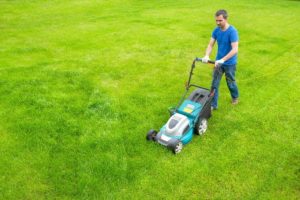 Tips for achieving a beautiful lawn
Tips for achieving a beautiful lawn
At Hartz Homes, we know that your vision for your home doesn’t end at the walls of your house. You likely picture a lush, healthy lawn as the perfect surrounding for your family’s home. So to help you out, here is some practical lawn maintenance advice, especially for the first-time homeowner.
How Do You Maintain Your Lawn?As you’re probably aware, keeping your lawn looking great is not a one-time job. You certainly won’t need to spend every day working on it, but it’s a good idea to set a schedule that includes the following activities.
Watering
It’s recommended to water your lawn deeply but infrequently, which usually means no more than one to two times per week and soaking the soil about six inches deep. This will encourage grass roots to grow deeper in search of water, which will ultimately make them more resistant to drought.
Mowing
How often you mow will depend on how quickly your grass grows. During the growing season, once a week is probably about right, but every other week should be fine when the grass is dormant. Just make sure not to remove more than about one-third of the length of the grass blades at a time. Cutting the grass too short or mowing with a dull blade can damage your lawn over time.
Fertilizing
Applying fertilizer once or twice a year can make a real difference in the appearance and health of your lawn.
Soil can start to run low on key nutrients and replenishing them with a slow-release, organic fertilizer improves soil health and grass growth.
Remember to stay away from quick-release fertilizers unless you have a pressing need for grass in a hurry. They’ll get your grass growing quickly, but they can deplete the soil in the long run.
Weeding
If you enjoy being outdoors and want to take your frustrations out on some weeds, you might be able to keep your yard weed-free using only your hands and a trowel.
Most people, however, will need some help controlling weed growth. Herbicides are available in both synthetic and natural varieties, but keep in mind that these are non-selective products — they’ll kill whatever plants they’re applied to, so make sure to apply them carefully.
Overseeding
Most of the time, you aren’t starting from scratch when you’re working on your lawn. Instead, you may see that your grass thins out over time.
One way to spruce it up is by overseeding, or spreading a blend of grass seeds on top of existing grass.
How often you need to overseed will depend on things like climate and the amount of foot traffic your lawn experiences, but you probably won’t need to do this more than every three to four years.
Aerating
Over time, weather and foot traffic can compact the soil, making it too dense to properly hold the water and nutrients that plants need and preventing grass roots from growing.
The way to fix this is by aeration, or introducing air into the soil. You can accomplish this with various spiked instruments, but whenever possible, you’ll want to use the plug or core aeration method, which digs up plugs of dirt and lets them recombine naturally into the ground. This requires a special lawn aerator, but you’ll only need it once or twice a year.
Pruning Trees and Shrubs
Fruit trees, in particular, require regular pruning to remove dead weight and make sure the leaves get as much sunlight as possible.
Shaded trees and shrubs don’t require quite as much work, but they should be checked from time to time for damaged branches or signs of disease.
Tree removal and replacement are expensive, so it pays to monitor the health of any trees or large shrubs on your property.
Eliminating pests
Some pests, like white grubs, can actively damage your lawn and even invite larger predators to come around looking for a snack.
Other pests like mosquitoes and ticks don’t harm plants but prevent you from fully enjoying your outdoor space.
Whether you opt for organic pest control or synthetic products, curbing unwanted visitors often becomes an important part of maintaining a lawn.
Here are some basic guidelines for a lawn care maintenance schedule:
| What to Do | How Often to Do It |
| Watering | 1-2 times per week |
| Mowing | Every 1-2 weeks |
| Aerating | 1-2 times per year |
| Fertilizing | 1-2 times per year |
| Seeding | Every 3-4 years |
| Pruning trees and shrubs | As needed |
| Weeding | As needed |
| Pest control | As needed |
Please check out these new home communities from Hartz Homes:
Armitage Pointe of Addison, Illinois (Chicago area new home construction)
Bella Vista Townhomes of Bolingbrook, Illinois (Chicago area new home construction)
Bluebell Ridge of Bolingbrook, Illinois (Chicago area new construction)
Lago Vista of Lockport, Illinois (Chicago area new home construction)
Leigh Creek of New Lenox, Illinois (Chicago area new home construction)
Marquis Pointe of Montgomery, Illinois (Chicago area new home construction)
Nantucket Lakes of New Lenox, Illinois (Chicago area new home construction)
Park West of Manteno, Illinois (Chicago area new home construction)
Playa Vista of Plainfield, Illinois (Chicago area new home construction)
Shannon Estates of New Lenox, Illinois (Chicago area new home construction)
Sky Harbor of New Lenox, Illinois (Chicago area new home construction)
Whisper Creek of Mokena, Illinois (Chicago area new home construction)
Hartz Homes has new home communities in:
Addison, Illinois (Chicago area new home construction)
Bolingbrook, Illinois (Chicago area new home construction)
Lockport, Illinois (Chicago area new home construction)
New Lenox (Chicago area new home construction)
Manteno, Illinois (Chicago area new home construction)
Mokena, Illinois (Chicago area new home construction)
Montgomery, Illinois (Chicago area new home construction)
Plainfield, Illinois (Chicago area new home construction)
